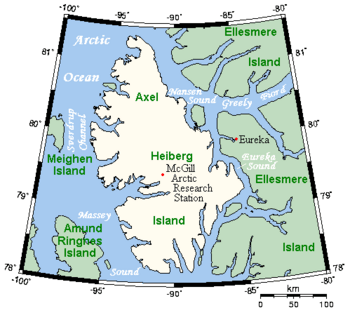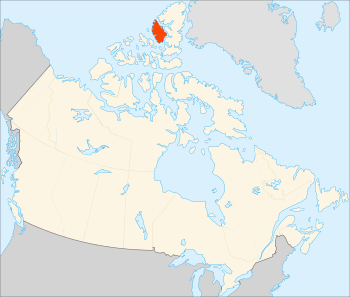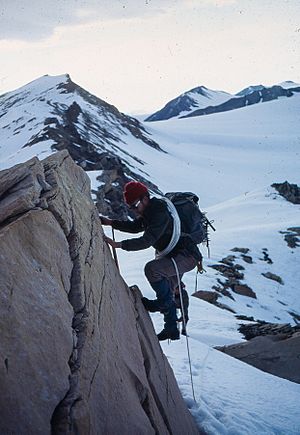Scaife Glacier facts for kids

Closeup map of Axel Heiberg Island
|
|

Location of Axel Heiberg Island
|
|
| Demographics | |
|---|---|
| Population | Uninhabited |
|
Sergeant
Kenneth Scaife
|
|
|---|---|

Expedition Photo August 1972, showing Kenneth Scaife climbing a rock-face
|
|
| Born | 30 June 1939 Yorkshire, England |
| Died | 9 August 1972 (aged 33) Axel Heiberg Island, Canada |
| Service/ |
Para, RAOC |
| Years of service | 12 |
| Rank | Sergeant |
| Unit | 31 Army Youth Team, Donnington, Shropshire |
| Battles/wars | Aden Emergency |
| Awards | GSM with Radfan bar |
| Spouse(s) | Edith Helen Scaife (née Stronach) |
The Scaife Glacier is a glacier found on Axel Heiberg Island. This island is located in the Qikiqtaaluk Region of Nunavut, which is part of the Canadian High Arctic. It's a very cold and remote area!
Why is it called Scaife Glacier?
This glacier is named after a brave soldier named Sergeant Kenneth Scaife. He was born in 1939 and sadly passed away in an accident on August 9, 1972. This happened while he was on an important British Army expedition in the area.
The leader of the expedition, Major John Muston, suggested the name "Scaife Glacier." He sent this idea, along with 37 other names, to the Canadian Permanent Committee on Geographical Names. Out of all those suggestions, only the name "Scaife Glacier" was chosen and accepted.
The Accident Story
On August 9, 1972, a small group of four people left their temporary camp, called Drop Camp. They were heading towards their main Base Camp, traveling across a glacier known as Airdrop Glacier.
They started their journey around 10:30 in the morning. By 11:00 AM, they were carefully moving through a difficult area with many deep cracks in the ice, called crevasses. It was raining heavily, and it was hard to see clearly.
The team managed to cross two big crevasses. As the first two climbers were crossing the third crevasse, an accident happened. One of the team members, Sapper Lewis, was pulling a small sled called a pulk. His pulk slipped off a narrow ice bridge, pulling him backward into the crevasse. Sergeant Scaife was close behind him. It's thought there might have been some slack in the rope connecting them. For some reason, Scaife couldn't stop Lewis from falling and was pulled into the crevasse as well.
The other two team members, Dilly and Lane, quickly unhooked their own sleds and rushed back. Dilly bravely climbed down about 20 feet into the crevasse but couldn't see Lewis or Scaife. He climbed back up, and they went to get more rescue gear from their sleds.
Returning to the crevasse, Dilly tied a piton hammer to a rope and lowered it down. Then, he used a special climbing technique called abseiling to go down the rope himself. When he reached the end of the rope, he was about 20 feet away from Lewis. He carefully moved over to Lewis, cut him free from his pulk, and moved him to a safer spot on a small ledge. He then wrapped Lewis in a tent to keep him warm.
Scaife was even deeper down, about 40 feet below Lewis, making him a total of 150 feet down. Since there wasn't enough rope, Dilly had to take the rope off and climb down to Scaife. He dug Scaife out from a pile of loose snow and was trying to help him when Scaife stopped breathing. Even though Dilly tried to revive him, Scaife did not recover. After making sure Scaife had passed away, Dilly returned to Lewis, who was starting to wake up.
It took Dilly and Lane about an hour to pull Lewis to the top of the crevasse, even with the help of a special pulley system called a Karabiner pulley. Seventeen hours later, a rescue team finally arrived to help Sapper Lewis. Sadly, it was decided that trying to recover Scaife's body would be too risky for the rescue team. The expedition leader held a burial service right there at the edge of the crevasse. Sapper Lewis survived the accident.
For his incredible bravery and efforts during the rescue, Lt Cdr Dilly was awarded the George Medal.
Who was on the Expedition?
Here are some of the people who were part of this British Army Expedition:
- Major A J Muston, the Leader
- Surgeon Lt Cdr P N Dilly GM, who was part of the accident party
- Sergeant K Scaife, who was also part of the accident party
- Cpl B R Lane
- LCpl M "Bronco" Lane, who was part of the accident party
- Sapper D F J Lewis, who was part of the accident party

